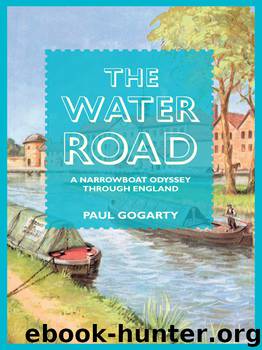The Water Road by Paul Gogarty

Author:Paul Gogarty [GOGARTY, PAUL]
Language: eng
Format: epub
ISBN: 978-1-909396-14-2
Publisher: Pavilion Books
Published: 2002-10-14T16:00:00+00:00
Freight-carrying and Pre-industrial Navigations
Adjacent to the lock, a bridleway skirts a two-mile lunar landscape known as St Aidens opencast mine. It looks as if a large comet has crash-landed into it. In fact it’s the land itself that crashed rather than an alien body. In March 1988 St Aidens collapsed and the River Aire flowed backwards into the depression for half a day filling the mines. Eventually the warrens were pumped out and miners became moles again. They shouldn’t have bothered. Now that the mine is virtually exhausted, the plan is to flood it once again over the next few years, transforming another toxic, hostile environment into a shimmer of reed beds, grassland and open water.
In the hour it takes to reach Castleford, I pass more than a hundred swans. Some are preening themselves, some are hanging their wings out to dry like washing, others snooze with their necks coiled like boat ropes on their backs, some tuck a tired paddling foot under a wing, and still others appear headless as they trawl beneath the water. There are no geese here, no ducks: it is swan heaven.
I try to identify the flapless flight of a bird doing extravagant loop-the-loops above a sloping field. It turns out to be a remote-control model plane. A tern soars, frantically beats its wings to maintain a stationary hover, and then plummets like a gannet straight into the water from twenty feet. It repeats this three times before it climbs away with a struggling fish in its beak.
At Castleford, a dreary, sprawling town, I moor at the junction before the flood lock, and explore a network of paths on my bike. Eventually they lead to Fairburn Ings Nature Reserve where I ask the first man with a name tag on his shirt how the reserve got its name.
‘Ings is a Viking word denoting a water meadow subject to seasonal flooding.’ The name tag pronounces the man to be Simon Stennett. ‘By draining the meadows, the Vikings made it possible to grow hay and graze cattle.’
Simon appears to be in his early to mid-thirties, has black floppy hair and a small silver earring. I comment on his southerly accent. ‘I’m from Kent originally, a country boy.’ As a country boy Simon used to steal off to the woods at every opportunity, climbing trees, investigating anything and everything. ‘I’ve never really grown out of it,’ he confesses. My fiancée says I’m still a big kid. Probably right. But now I get to drive around on tractors and use chainsaws to cut down trees which is even more fun … and I’ve got a seven-hundred-acre garden to do it in.’
The R.S.P.B. Site of Special Scientific Interest is Beauty and the Beast in one: a refuge of splendour and conservation built on a slag heap. Covering three exhausted mines, the area has become a major nature reserve with 251 different birds spotted by 60,000–80,000 annual visitors.
Armed with a leaflet I leave Simon and make my way along a boardwalk through a swamp.
Download
This site does not store any files on its server. We only index and link to content provided by other sites. Please contact the content providers to delete copyright contents if any and email us, we'll remove relevant links or contents immediately.
How to Read Water: Clues and Patterns from Puddles to the Sea (Natural Navigation) by Tristan Gooley(3430)
Full Circle by Michael Palin(3413)
Into Thin Air by Jon Krakauer(3346)
How to Read Nature by Tristan Gooley(3289)
In Patagonia by Bruce Chatwin(2893)
The Lost Art of Reading Nature's Signs by Tristan Gooley(2659)
A Thousand Splendid Suns by Khaled Hosseini(2646)
Don't Sleep, There Are Snakes by Daniel L. Everett(2594)
Venice by Jan Morris(2545)
The Queen of Nothing by Holly Black(2538)
City of Djinns: a year in Delhi by William Dalrymple(2528)
The Songlines by Bruce Chatwin(2519)
L'Appart by David Lebovitz(2502)
The Big Twitch by Sean Dooley(2410)
Tokyo Geek's Guide: Manga, Anime, Gaming, Cosplay, Toys, Idols & More - The Ultimate Guide to Japan's Otaku Culture by Simone Gianni(2343)
Come, Tell Me How You Live by Mallowan Agatha Christie(2225)
A TIME OF GIFTS by Patrick Leigh Fermor(2173)
Iranian Rappers And Persian Porn by Maslin Jamie(2171)
INTO THE WILD by Jon Krakauer(2170)
